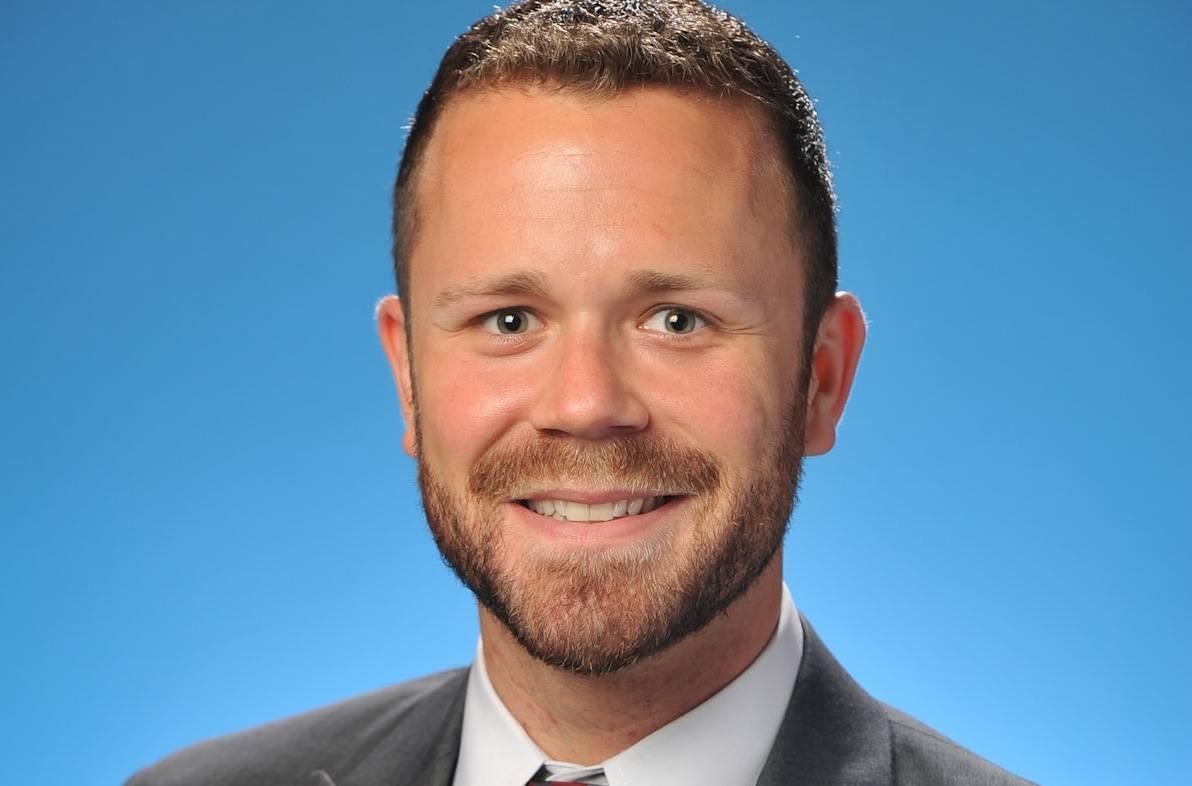Interface Dives In For New Belgium Brewing


A group of Interface employees are pictured on the company’s blog site in bathing suits in the Chattahoochee River in Atlanta holding carpet tiles that spell out, “We're with you.” Why would employees from Interface, a company that makes modular carpet tiles, stand in their swimsuits holding a sign? They're voicing support for New Belgium Brewing Co., which is facing a boycott in a Colorado town over donations to environmental groups.
When the news came out earlier this summer that New Belgium donated to the nonprofit group WildEarth Guardians, the northwestern Colorado town of Craig started a boycott of the craft brewing company. Craig is a coal-mining town, and WildEarth Guardians brought a lawsuit against the Department of the Interior over its environmental impact assessment. Many residents in Craig depend on work in the coal mine.
GreenBiz reported that last May “judges found officials had given the green light to an expansion of the mine without considering the full environmental impacts of burning more coal.” The Department of the Interior will not appeal the ruling.
New Belgium is a company that believes strongly in sustainability. As stated on its website, “We believe in using every tool at our disposal to create the vibrant future we envision for the earth and her inhabitants.” It’s a company that puts its proverbial money where its mouth is, as is evidenced by its support of WildEarth Guardians. Not bad at all for the fourth largest brewing company in the U.S.
Judging by statements by Dana Villeneuve, sustainability specialist at New Belgium, the brewing company is not deterred by the boycott in Craig. “We work very hard to be very, very frank about how much coal and natural gas we use to make our beer because we think it would be incredibly hypocritical of us to do otherwise,” Villeneuve said. “And simultaneously we believe in advocating for a future where renewables are a bigger piece of the pie.”
Interface’s support of New Belgium speaks volumes about its commitment to sustainability. As stated in a blog post, Interface employees stood in the Chattahoochee River in Atlanta to “tell another courageous business that we support them.” Interface and New Belgium are clearly two companies with a passionate and deep commitment to creating a better future. With companies like them, we really do stand a chance of carving the kind of future that the planet and its people need.
Image credit: Interface
Craft Breweries Support Sustainability


By Daniel Matthews
The 2014 numbers for America’s craft beer industry are in, and crafties are excited. The industry is in the midst of a renaissance. Craft brewing is at an all-time peak, with diversity reigning and craft breweries contributing to the sustainability efforts of local economies.
According to the Brewer’s Association, in 2014 craft breweries numbered at nearly 3,500, a 19.4 percent increase from 2013. In terms of market share, craft beer sales accounted for 11 percent of intake, with a 22 percent growth in sales from 2013.
Alongside the daily reality of watching these breweries thrive, the growing numbers are heartening for advocates of sustainable economies.
First, let’s get our terms straight. Exactly what is a craft brewery? The temptation is to say it’s any brewery that crafts small batches of specialty beer. But the craft beer craze is marked by desire for a more specific level of exclusivity, a higher standard some mistake as snobbery.
A craft brew isn’t considered a craft brew unless the grain portion is all-malt (instead of rice or corn). Besides malted barley, hops, yeast and water, any added ingredients must contribute flavor. A craft brewer must produce 6 million or fewer barrels per year. And 75 percent of the company must be owned by a hands-on party, not a member of the alcoholic beverage industry.
American beer sales are dominated by Anheuser-Busch InBev, which produces 18.1 percent of the world’s beer. U.S.-based Anheuser-Busch merged with InBev, a Belgian-Brazilian conglomerate, to create AB InBev in 2008.
The craft brew standard is specifically formulated to exclude producers like AB InBev, but the company continues to buy out breweries in an effort to harness the craft craze. The buy-outs redefine “craft brewery." Brewers get to continue their work unchecked, producing the same products with the same level of care -- the same “craft." But they leave the 75 percent ownership stipulation by the wayside.
In my hometown, one of the sell-outs is 10 Barrel Brewing, which has a brewpub in the heart of downtown Boise, Idaho. The brewery's sale to AB InBev last year raised controversy due to Idaho’s law that grants special rights to small brewers. According to the law, if 10 Barrel isn’t a small brewer anymore it can’t operate a brewpub, i.e. it can’t sell directly to the consumer. Large brewers are required to sell through an independent retailer so they can’t monopolize the system.
In June, the state determined that 10 Barrel can continue its brewpub because AB InBev isn’t an Idaho licensed brewer, effectively giving 10 Barrel a loophole. The place may look local, but now a good percentage of the dollar you spend there will go to AB Inbev. Not a lot of that dollar will go toward sustaining the local economy. But 10 Barrel’s business will thrive.
Still, despite the lure of the corporate dollar, thousands of craft breweries around the nation hold out and continue independently contributing to sustainable local economies. One of the new, exciting upstarts in Boise is called Payette Brewing Co. Voted Best Local Brewery, in 2016 Payette plans on opening a $4.5 million production facility in downtown Boise.
Owner Mike Francis is a former engineer for Boeing who decided to pursue his brewing dream by founding the brewery in 2010. Francis is an Idaho native. The state makes starting your own business a snap, so locating the brewery here made perfect sense.
One of the ways Payette gives back to the community is through its Payette Forward program, which donates to nonprofit organizations and sponsors events, as long as the organization throwing the event is a nonprofit. Payette prefers not to give to political and religious applicants, unless they are all about an independent cause, such as supporting the local food bank. Payette partners with local food trucks that set up shop right out front of the pub.
Payette has also partnered with Ninkasi Brewing, a Eugene, Oregon, member of the Willamette Valley Sustainable Foods Alliance. Ninkasi ranks as No. 36 on the Brewers Association's list of the top 50 craft brewers in 2014.
Distribution is one of the biggest concerns for craft brewers trying to make a living. In January, Ninkasi resisted the AB Inbev pull and opted to go through two regional distributors, in part to stay aligned with the values of “independent and local wholesalers." Additionally, Brewpublic reports that Ninkasi will team up with Maletis Beverage to give money from every keg sold in September to the Portland Firefighters Association, Local 43. With the high volume of fires this season, it’s safe to say this is a good cause.
Overall, you can’t blame a brewer for wanting to harness the distributive power of a large brewing company like AB Inbev. But the diversity, integrity, creativity and sustainability companies like Payette and Ninkasi bring to the field goes a long way toward helping America’s craft brewing revolution and local economies thrive. Here’s to more amazing new brews in America!
Image credit: Flickr/Visit Florida Editor
Daniel Matthews is a beer enthusiast, freelance writer, and musician. He's written for Social Media Today, GM-Volt, Smart Data Collective, and YFS Magazine. You can find on Twitter @danielmatthews0.
New effort to reshape fossil fuel firms approach to climate change


The heat is on for fossil fuel companies in more ways than one with the launch of a major new initiative to build stronger leadership by oil, gas and coal companies on climate change.
The 'Heat Is On' initiative is guided by a Senior Advisory Panel made up of former and current leaders from industry, government, international organisations and civil society including Lord John Browne (executive chairman of L1 Energy and former ceo of BP), Connie Hedegaard (former EU Commissioner for Climate Action), Prof Dame Julia King (member of the UK's Committee on Climate Change and former senior Rolls-Royce executive) and Sir Mark Moody-Stuart (former chairman of Shell and Anglo American)
It is led and co-ordinated by Critical Resource, an advisory firm supporting responsible practices in the extractive industries.
Critical Resource says that the goal of the initiative is to enable oil, gas and coal companies to play a meaningful and important role in helping the world to limit global mean temperature rise to 2 °C above pre-industrial levels, the internationally-accepted policy goal. The initiative is a quest for ‘big ideas’ on how the industry can transform itself to operate profitably in carbon-constrained world, it maintains.
The first phase of the initiative will involve a period of engagement and dialogue with senior industry executives and independent experts to develop ideas for practical changes the industry can make.
The results of this first phase will be published in advance of the upcoming United Nations Climate Change Conference of the Parties (COP21) in Paris later this year.
Twitter Chat Recap: Dow Chemical Co. Hosts Circular Economy Chat at #EnergyBag


Today TriplePundit, Neil Hawkins, Jeff Wooster and Andrew Winston came together for a special Twitter Chat about the circular economy and the innovative Energy Bag project.
During this hour-long Twitter Chat, we took an analytical look at the circular economy in America. We discussed the transition to a circular economy, where waste is designed into new products and services. We also took a deeper look at how consumers can turn plastic into energy.
The Dow Chemical Co. worked with the city and citizens of Citrus Heights, California, on the Energy Bag pilot program. Over the course of the three-month program, 7,800 households collected nearly 8,000 bags of plastic waste, which was turned into 512 gallons of synthetic crude oil. Most importantly, nearly 3 tons of plastic waste was kept out of landfills!
Prompted by TriplePundit, Hawkins, Wooster and Winston addressed the following topics, and more:
- How The Dow Chemical Co.’s #EnergyBag pilot program is increasing excitement about the value of the circular economy,
- How Citrus Heights residents experimented in a case study with the purple bag; what they learned,
- How non-recycled plastic items like juice pouches and candy wrappers can be converted into energy,
- What this project has done to increase homeowner knowledge about plastic recycling,
- How the Energy Bag pilot helped to identify a way to keep more material out of the landfill,
- How you can encourage neighbors in your town to start a similar program!
FEATURED GUESTS WERE:
- Neil Hawkins (@NeilCHawkins) – Corporate Vice President and Chief Sustainability Officer, The Dow Chemical Company
- Jeff Wooster (@JeffWoosterRS) – Global Sustainability Director, Dow Packaging and Specialty Plastics
- Andrew Winston (@AndrewWinston) – Author of "The Big Pivot," co-author of "Green to Gold"
MODERATORS WERE:
TriplePundit's team including:
- Nick Aster (@NickAster) — Founder and Publisher
- Marissa Rosen (@MarissaR1) — Director of Social Media
- Jen Boynton (@JenBoynton) — Editor-In-Chief
- Mary Mazzoni (@Mary_Mazzoni) — Senior Editor
Report: Carbon Credits Under Kyoto Protocol Actually Increased Emissions


At the end of November, governments will come together in Paris to hammer out agreements for a successor to the Kyoto Protocol. Under the KP, there are two greenhouse gas (GHG) emissions offsetting mechanisms: joint implementation (JI) and the Clean Development Mechanism (CDM).
JI allows countries with emissions-reduction commitments under the Kyoto Protocol to generate Emission Reduction Units (ERUs) from GHG reduction projects and transfer them to other countries. Almost 872 million ERUs had been issued under JI as of March 2015, about a third of all Kyoto offset credits. In a nutshell, JIs are carbon credits and include things like reforestation projects.
Perhaps government heads should read this recent report by the Stockholm Environment Institute (SEI), which found that the use of JI actually may have enabled GHG emissions to be about 600 million tons of carbon dioxide equivalent (tCO2e) more than if countries had met their emissions targets domestically.
Ukraine, Russia, Poland and Germany have the highest ERU issuances. Those four countries have 439 projects registered and over 800 million ERUs issued, which account for 94 percent of ERU issuances. The report found “environmental integrity concerns” for over 80 percent of ERUs in Russia and Ukraine. By contrast, environmental integrity in Poland was rated at 70 percent and 97 percent in Germany.
That is troubling because, as the report points out, the design of JI should prevent that from happening. The whole point of JI is to reduce emissions. Each country with an emissions target receives allowances called Assigned Amount Units (AAUs) that are equivalent to its total emissions budget for the commitment period. A host country has to cancel one AAU for every ERU it issues. So, if a JI project is either over-credited or not additional, the host country would have to make up the difference with more mitigation action.
So, what went wrong? Several countries had emissions targets during the first commitment period that were well above their business-as-usual emissions. That caused large AAU excesses. When that happens, host countries can use surplus AAUs to cover their ERUs, which allows them to not take additional mitigation action -- allowing over-credited or non-additional JI projects to cause higher global emissions.
What’s the fix?
What can be done to fix the JI mechanism? The report recommends several things, including:
- Project cycle procedures should ensure full transparency with all documentation publicly available. That is needed because lack of transparency is a big concern in some JI host countries where full documentation for the projects is not publicly available.
- Only internationally accepted methodologies should be eligible for use. The trouble is that many projects applied their own approaches for additionality demonstration and the calculation of emissions reductions. In many cases, they ended up using inappropriate approaches.
Hammering out a good climate change agreement is important, and that includes fixing the problems with JI. Hopefully, the powers that be will take note
Image credit: Reforestation via Flickr
Vivergy Makes the Connection Between Climate, Emissions and Your Family’s Health


While it’s been difficult to motivate a number of people to take action or even feel concerned about climate change, some have succeeded by linking the presence of emissions and poor air quality with health issues, perhaps because that hits closer to home. The EPA, for example, has based many of its economic arguments for reining in air pollution on the millions of dollars in health care costs that can be avoided. China, where over a million people die each year due to air pollution, has certainly become the poster child of what can happen at the intersection of the two issues.
But what about here in the U.S.? Do we have cause for concern? Is anyone linking climate-disrupting fossil fuel emissions with health impacts right here at home in our families and communities?
A newly formed company called Vivergy (combines the Latin root for “life” and energy) is doing just that. Its website allows you to see what the air quality is in your town and relates it back to secondhand smoke. I was surprised to learn that in the city I call home, Rochester, New York, the air pollution level is equivalent to having a smoker living in my home three months out of the year. The site also provides tools to assess your impact and suggestions for how you can reduce it.
I spoke with Vivergy’s founder and CEO, Kevin Kononenko, a recent University of Michigan graduate, about this undertaking.
TriplePundit: What got you interested in this?
Kevin Kononenko: It is incredibly hard for the human brain to understand large-scale ecosystem change. When communicators discuss issues in terms of long timeframes, global scale and scientific units, it is super hard for people to emotionally connect on a daily basis. I wanted to find a way to bring energy issues down to the human scale -- right here (wherever your community is) and right now.
Air pollution provided this opportunity since it is a much more localized phenomenon than many environmental issues, and we have an awesome monitoring network here in the United States that spits out data hourly. But that was not going to be enough, since the data is measured in micrograms per cubic meter of particulate matter. So, I did research in the field of human exposure science until I found studies that specifically compared air pollution and cigarette smoke in terms of PM2.5 (tiny particles in the air that can enter the lungs). And then people could actually connect to the data and see how it affected them and their loved ones.
3p: What is the key message you want people to know?
KK: People should know that their energy decisions affect the wellbeing of children in their community, but there are a few things you can do about it. Much like the concept of secondhand smoke, when you use dirty fuels for home energy, in your vehicle, for shipping your goods or traveling via plane, air pollution enters your community and affects the health of those around you. Children and older folks with asthma are especially sensitive.
At the same time, if you are able to reduce your use of these dirty fuels, you actually stand a chance of experiencing the positive impact of your actions. Example: In a couple cases, groups have placed air pollution monitors at schools and observed the patterns of pollution in that micro-environment over the course of the day. What they find is that pollution peaks while many parents and buses are sitting in the parking lot dropping kids off and picking kids up. So, if people are able to stop idling and carpool, they could actually see a measurable change in exposure!
3p: How will your website help?
KK: The Share My Air tool allows individuals to compare air pollution in their community to other communities across the U.S. in understandable terms (cigarette smoke), so they know what they are exposed to exactly. The main Vivergy site allows you to find your Pollution Score, which is a measure for your impact on local air pollution. After that, we can give you customized goals that allow you to reduce your Pollution Score and watch as you improve relative to community members. We also allow groups to sign up to see who can become a clean air champion within your particular group and to hold others accountable for taking action.
3p: What has been the response so far?
KK: Almost every single person has really appreciated the cigarette messaging and has been thankful that the numbers are in understandable (and occasionally shocking) terms. This is regardless of their background on air pollution science, which is very encouraging.
Now we are trying to get some groups signed up on the site, because it is no fun to fight local air pollution alone! Most parents would be very uncomfortable with their child spending 26 minutes a day in a car with a smoker, so now the question is whether we can help them act on that in ways that they feel are meaningful and reasonable. But the key is that every single parent shares this value and agrees that it may not align with the other ways they take care of their kids.
3p: How does participation take you beyond your personal contribution?
KK: One thing I am curious to learn about as the site develops and users sign up is how this changes the cultural connotation of using dirty fuels. Since the site is auto-reporting all positive actions logged, it creates a ton of reminders for each individual that others are taking action and they can too.
So, rather than just putting in LED bulbs and wondering what actually happened, you get to log that on the site, watch your score fall, and then others know that at least one person is making the transition to LED bulbs. It creates social transparency so it becomes more reasonable for all to act on local air pollution. I am very curious to see how this can influence behaviors - every action logged will serve as a reminder that these changes are possible and happening all around you.
3p: What are some of the best and worst places in the U.S. for air quality?
KK: The worst place for air quality is the Central Valley of California, including places like Fresno, Madera and Merced. It is surrounded by mountains, so air in the valley is trapped, and a combination of agricultural dust and vehicle emissions can build up there.
Some of the best places in the U.S. are in the Pacific Northwest, places like Portland and Seattle. Since it rains so frequently there, the pollution is consistently cleared and rarely accumulates to high levels.
Image credit: Vivergy
Q&A: Recent Grad Tim Trefzer Talks Green Events and Sustainability Leadership


The decision to pursue higher education can be unnerving, especially if you've already found a job you love. But Tim Trefzer, a recent graduate of the Executive Master’s in Sustainability & Leadership (EMSL) program at Arizona State University, proves it's possible to get the best of both worlds.
By choosing a degree program that allowed him to study in person and online, Trefzer was able to keep his dream green job -- overseeing environmentally-friendly events and sports games in Atlanta -- while gaining new skills to help him do the job even better.
TriplePundit talked with Trefzer to find out more about his decision to pursue a sustainability education and how it impacted his career.
TriplePundit: Let's start by talking about your experience at ASU. What was your focus of study, and when did you graduate?
Tim Trefzer: I was one of 15 in the first Executive Master’s in Sustainability & Leadership (EMSL) program at ASU. The program was focused in four key areas designated for sustainability professionals: global context, strategy, communications and leadership. I graduated in January 2015, and because the program was conducted both in person and online, I was able to maintain my position in Atlanta while pursuing my degree.
3p: What made you decide to pursue a sustainability degree?
TT: I’d actually been seeking a graduate degree program for some time before discovering EMSL. I realized that people in positions I aspired to be in primarily had graduate degrees, and having studied business as an undergraduate at Florida State University and not sustainability, I wanted to fully emphasize sustainability comprehension. The four core concepts in EMSL were precisely what I had hoped to improve, so I found the program to be a good fit.
3p: What are you up to now? Briefly describe your current role and responsibilities and how long you've been on the job.
TT: Since 2010 I’ve overseen the sustainability journey of the Georgia World Congress Center Authority, which owns and operates the 3.9 million-square-foot Georgia World Congress Center, the 71,250-seat Georgia Dome, and 20-acre Centennial Olympic Park, and also manages the Savannah International Trade and Convention Center.
I have several areas in which I focus, including improving operational efficiencies, waste collection and diversion, LEED certification (the GWCC is the world’s largest LEED certified convention center), environmental strategic planning, communications, and community and event outreach and engagement.
Working in the events industry provides a unique stage to create and influence environmental and societal change both inside and outside of our organization, and I feel fortunate to have a powerful platform to see and support that change.
In 2013, I chaired the sustainability committee for the Men’s Final Four held in Atlanta, which the NCAA deemed to be the greenest in its history. I’m also on the board of directors for the Green Meetings Industry Council (GMIC), representing a traditionally wasteful industry that has embraced (and is now leading) its own sustainability movement.
Driving sustainability forward in an industry and in a region of the country that isn’t historically environmentally progressive is what drives me to continue to do this work.
3p: Have you found that your sustainability education was a benefit in the field?
TT: Definitely. And I continue to find new ways that it benefits me. Not only was I able to apply concepts from the classroom to issues I was facing on a day-to-day basis, but I was also exposed to the various issues my peers in other industries were facing so that I could anticipate how they would affect me and my role at the GWCCA. Speaking of peers, I’m able to tap into the ASU School of Sustainability’s extensive network of professionals, which I’ve discovered is an invaluable resource. The sustainability industry is still relatively small, and connecting through this network only helps to unify and advance our movement.
3p: Do you have any advice for students who are thinking about a sustainability degree?
TT: I’m a big believer in continuing education and would certainly encourage folks considering a degree in sustainability to explore all of their options based on individual goals or desired career path. Some sustainability degrees only take into account environmental considerations, while others emphasize the financial component as to sell sustainability in business. Fortunately, more schools are developing sustainability degrees, so the variety and quantity of options continue to grow.
3p: What's your biggest sustainability pet peeve and why? Disposable grocery bags? Trash in the compost? Cars double-parked in the bike lane? Share your thoughts!
TT: Hmm… I have to pick just one?! Just kidding. I’ll sound like I’m on my soapbox, but I find it peculiar that so many environmentalists and sustainability professionals eat meat. Most are aware that cutting out meat is one of the best daily choices that one can make to reduce environmental impact.
I understand that there are more sustainable meat options, and that an occasional indulgence is likely the best I could expect from most. Yet I still find it funny when, especially at conferences, we’ll go from discussing the resource effects of factory farming to a chicken and pork lunch without batting an eye. I’ll step off my soapbox now.
Time for Snack Food Companies to Commit to Ethical Palm Oil


There are time when companies need more information to act – for example, making implementable drought-action plans. But there are times when lack of action is the equivalent to allowing atrocities to occur. Rainforest Action Network (RAN) is calling out 20 laggards that are, by refusing to enact strong palm oil procurement policies, allowing for social and environmental violations to spread on the other side of the world.
Palm oil cultivation is a known problem. It is a chief driver of deforestation in Southeast Asia, decimating the homes of Sumatran rhinos, tigers and elephants. This deforestation is also a chief cause of carbon emissions, and scientists strongly believe that if we are to avert catastrophic climate change, then deforestation needs to be stopped -- and fast.
That, of course, doesn't get into the other ethical issues facing palm oil. In the past, plantations have been known to use child labor, are an end-point for human traffickers and often treat workers viciously. Palm oil plantations spreading into indigenous lands is also a chief source of conflict as deforestation encroaches into traditional lands, oftentimes holy lands.
This palm oil ends up all mixed together in global supply chains, and ends up in our packaged goods. Remember the big move against trans-fats? They are most often being replaced by palm oil, which, in less than 15 years, has gone from being a barely used good to one of America's most consumed oils.
Rainforest Action Network is calling out 20 snack food companies including Kraft Foods Group, Hillshire Brands Company, Grupo Bimbo, H.J. Heinz Company, Campbell Soup Company, Hormel, Unilever and PepsiCo for not doing enough to stop the use of conflict palm oil in their products.
“As palm oil plantations continue to spread across Indonesia, Malaysia and beyond to Africa, Papua New Guinea and Latin America, endangered rainforests are falling faster than ever and systematic abuse of communities and workers’ rights remains rife throughout the industry,” said Gemma Tillack, agribusiness campaign director for Rainforest Action Network (RAN).
RAN believes that companies have an obligation to implement strong, independently-verifiable standards and account for every single drop of palm oil in their supply chains to ensure it comes from ethical sources. There is, in RAN's mind, no excuse for gigantic multinational companies with millions, sometimes billions, in revenues to not practice this common-sense supply chain management.
Several of the companies are those whose products your everyday purchases. This includes: Kraft Foods Group, Nissin Foods, Hillshire Brands, Heinz, Campbell Soup, Hormel and PepsiCo.
The biggest name in this list is, without question, PepsiCo, owner of several palm oil containing products including Frito Lays, Quaker Chewy Granola Bars and Cheetos. As one of the biggest distributors of food and beverages, and with a supply chain that extends to nearly everywhere in the world, PepsiCo should be a leader, not a laggard, when it comes to palm oil
“The global palm oil industry is fast approaching a tipping point and PepsiCo’s global scale and influence gives it a crucial role to play in finally eliminating Conflict Palm Oil from our food supply," said Rainforest Action Network’s Ginger Cassady in a press statement.
RAN plans numerous actions to raise awareness of the Snack Food 20 and push them to implement stronger palm oil procurement policies that will help save Southeast Asia's forests. Click here to stand with them today.
Image source: Wikimedia Commons
#NowTrending: Enlightened Brands


Ever since Oreo won the Internet with its infamous ‘Dunk in the Dark’ tweet, marketing gurus, brand strategists and social media experts everywhere have been on a mission to craft the most ‘human brands.' These are brands that use empathy, accessibility and a dose of humor in an effort to better connect with consumers.
However, somewhere along the line this trend took a turn for the worse, leaving us with sex toy manufacturers tweeting about 9/11 and “brands saying bae." It is no longer enough for our brands to simply be human; today’s consumers are looking for brands to be enlightened.
According to TrendWatching, enlightened brands are brands that have evolved to a higher state of consciousness. They take real, meaningful, sometimes even painful, action to make their lives – and the world we share – better. These brands are restless. They are constantly in search of new ways to make the world a better place. They hold themselves to higher standards of fairness and responsibility.
Enlightened brands are empathetic. They understand their customers’ pain points and work to make their lives better, easier, and more enjoyable. Enlightened Brands are also demanding. They push consumers to be the best that they can be. Here's a summary:
Restless brands
In a global survey, 63 percent of consumers said that they only buy products and services which appeal to their beliefs, values or ideals. It is becoming increasingly important for brands to not only be eco-conscious and socially aware, but for them to actually take action toward these beliefs. Enlightened brands take steps toward a better world by developing products, services and systems for the greater good.
One powerful way big brands are moving closer to enlightenment is to let change start from the inside. They are creating new, fairer, more equal ways of approaching internal corporate culture. In March 2015, Vodafone announced that it would implement a worldwide minimum level of maternity pay. All women would be entitled to 16 weeks of maternity leave on full pay, plus full pay for a 30-hour week for the first six months after they return to work. The company, which has over 100,000 employees in 30 countries, will support those who do not have a legal provision for maternity pay.
Enlightened brands use new, innovative processes to reduce waste and benefit the environment. Cambodian fashion brand Tonlé manufactures its garments from scrap materials and then collects its own scraps to create new, usable fabric with zero waste.
Enlightened brands also empower their consumers to do good. Gramming for Good and Gramforacause are two platforms that connect socially-conscious Instagrammers with nonprofits. They use photography to spread the word about the work of the nonprofit, while offering photographers the opportunity to earn cash for their effort.
Empathetic brands
Enlightened brands are empathetic. They are human-centered. They understand their customers, how they live and what they can do to make their lives better. In order to make things more convenient for their patrons, the Grand Hyatt hotel in Melbourne, Australia, recently launched a Leave it at Hyatt program which gives travelers the option to leave items at the hotel between stays.
During the SXSW Festival in March 2015, U.S.-based battery manufacturer Mophie teamed up with the St. Bernard Rescue Foundation to offer a mophieRescue service. Attendees were invited to send a tweet to the brand along with a screenshot of their dying battery and current location with the #mophieRescue hashtag. The rescue dogs arrived shortly with a charger.
Finding new ways for customers to make constructive use of infrastructure is good for society and the planet. Idea Bank is a cafe and co-working space for entrepreneurs. The bank offers free beverages, offices, Wi-Fi and printers to entrepreneurs and small companies.
Demanding brands
Enlightened brands push consumers to do better and be better. In an effort to push customers to do more physical activity, the Mexican government installed 30 motion-sensitive machines at subway stations across Mexico City. The machine issues a token that can be redeemed for a subway ticket to any commuter who completes 10 squats. This project was introduced in response to the 2013 United Nations report stating that 32.8 percent of the Mexican population is obese.
Enlightened brands encourage consumers to be more responsible. In May 2015, U.K. television station E4 shut down on the day of the general election to push young people to go out and vote. The station, which reaches 8.7 million people between the ages of 16 and 34 every month, acted in response to the fact that less than half of the country’s youth voted in the 2010 British general election.
Being demanding also means finding innovative ways to improve customer behavior. Australia’s Art Series Hotel Group recently launched a promotion that offers guests the chance to earn discounts and upgrades in return for their behavior in the hotel being reviewed. Any guests who have a rating of four stars or higher are rewarded with complimentary food, beverages, stays or upgrades.
The future of enlightenment
The truth is, there are plenty of big brands that are still resolutely unenlightened. As of May 2015, the shareholders of eBay voted overwhelmingly against releasing information about the gender pay gap in the company while companies such as Twitter and Facebook were sued for sex discrimination.
Then, there are companies like Starbucks, which launched a Race Together campaign to open up a discussion about race relations in the U.S. and was accused of being opportunistic. Innovating around the right trends can see any brand get closer to enlightenment but consumers can often sniff out any attempts that don’t appear to be genuine.
Even In 2015, few brands are anywhere near true enlightenment. Most are deeply mired in eco, social and service sin. But any business can learn from the major brands that are taking their first steps and the startups introducing the kind of enlightened innovations that can change the world for the better.
Image credits: Gramming for Good, Flickr/MarkScottAustinTX, Art Series Hotel Group, Flickr/Rekre89, Flickr/Brian James Henry
SmartHalo Exceeds Kickstarter Goal on Day One


Montréal, Québec, Canada is among the world’s top biking cities. Never mind that its winters can be grueling and its hills a supreme hassle, the city’s protected bike lanes and innovative mindset when it comes cycling has put it in the list of top cycling cities in the world.
So, it is no surprise that Montreal has also become an incubator for cycling technology. It gave us the Bixi bike-share concept (which went on to spawn popular bike-sharing programs in Toronto and New York), and now it’s given us SmartHalo.
Dreamed up by Cyclelabs, SmartHalo is designed to do everything we generally believe a bike can’t do: navigate the route, monitor its security and pamper the rider’s personal needs en route. The little apparatus, which sits atop the handlebars, tracks distance, calories, elevation, usage and security, all of which can be easily viewed on a phone. Once the rider disembarks, the bike goes into sleep mode, a security setting that tracks the status and the location (just in case you forget where you left your bike).
Best of all, the connection uses Bluetooth Low Energy, answering one of cycling “smart” technology’s biggest challenges: small batteries versus big ambitions. The gizmo also recharges within minutes, so the rider isn’t left sitting waiting.
And SmartHalo’s simple design -- says the company’s director of user experience, Gabriel Alberola -- is all part of the package.
“SmartHalo’s design philosophy has always been centered on minimalism and simplicity. Biking in cities is already a challenge so our product needed to be smart yet easy to use, without being another distraction,” Alberola said.
Unlike a number of similar innovations already on the market, SmartHalo easily attaches and becomes a permanent “smart” part of your bike. Once the route is keyed into the app, SmartHalo takes over, feeding directions to the rider from color-coded signals that can be seen en route. Printed maps and frustrating pull-overs to check directions become passé. The smart apparatus plots and directs the route from start to finish.
The apparatus is geared to mesh with any bike on the market, and the app is iOS and Android friendly. Not surprisingly, these Montreal entrepreneurs have also factored in climate change and winter weather by making the apparatus waterproof.
Last Tuesday, after months of planning, SmartHalo launched its Kickstarter campaign for an ambitious $50,000. Previous Kickstarter entrepreneurs have pointed out that the way to success is to aim low when it comes to a financial goal, and aim high when it comes to forethought, planning and turnaround. So, the outcome of this campaign is as much a testament to Cyclelabs’ deep research and thought as much as it is to the marketability of its concept.
On Tuesday, less than 24 hours after the campaign launched, Cyclelabs met its goal of $50,000. And it was still climbing Wednesday morning. At 12 noon ET, it had already surpassed $60,000.
One reason for that success may be its introductory price of $79, a steal compared to similar smart cycling tools, which can reach $200 or more. The first 100 perks were gone within hours, but that hasn’t stopped the sale of double packages, which still go for about half the retail price.
For now, the Kickstarter campaign (which expires Sept. 24) is the most economical and quickest way to try out the new smart apparatus. The designers haven’t said when it will hit the market, but with momentum they have received this week, the designers already know that they are on to a very marketable concept.
https://www.youtube.com/watch?v=lfbKndy0l6o
Image creditss: SmartHalo